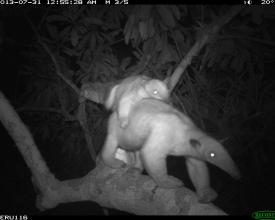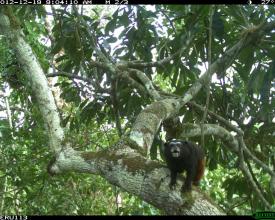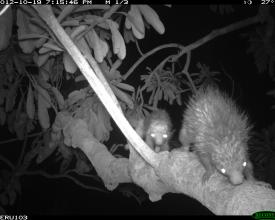Relier les habitats des espèces arboricoles à l'aide de ponts de canopée

Les mammifères vivant dans les arbres tropicaux, tels que les singes, les kinkajous et les opossums, dépendent d'autoroutes complexes au sommet des arbres pour atteindre leur nourriture, leurs partenaires potentiels et éviter les prédateurs au sol. Dans le cadre de l'une des plus vastes études de piégeage par caméra dans la canopée, les scientifiques du Smithsonian Conservation Biology Institute et leurs partenaires ont constaté que, lorsqu'un pipeline en construction au Pérou menaçait ces autoroutes, le fait de laisser des ponts naturels, ou des branches de connexion, pour les espèces arboricoles réduisait réellement la gravité de l'impact.
"Ici, nous avons travaillé en partenariat avec l'industrie pour identifier un problème, mettre en œuvre une solution proposée et utiliser une technique innovante de piégeage par caméra pour tester la solution. Les résultats montrent clairement et avec force l'efficacité d'un moyen simple de réduire les impacts de l'activité humaine sur la biodiversité - un rêve pour les biologistes de la conservation", a décrit l'un des chercheurs. Ces résultats sont maintenant en cours d'incorporation dans la législation péruvienne.
Impacts
Les photos prises par les pièges photographiques ont montré qu'au cours d'une année de surveillance, les mammifères arboricoles n'ont traversé la zone de dégagement du gazoduc que 16 fois au sol. En revanche, plus de 3 000 animaux arboricoles ont traversé les ponts de la canopée naturelle laissés au-dessus de la zone de dégagement du gazoduc. Le taux de passage des mammifères sur les ponts était plus de 100 fois plus élevé qu'au sol, et 25 espèces de mammifères arboricoles ont utilisé les ponts naturels, alors que seulement six de ces espèces les ont traversés au sol.
Les résultats de cette recherche sont actuellement en cours d'intégration dans la législation péruvienne. Les entreprises engagées dans le développement d'infrastructures pourraient être tenues de laisser des ponts de canopée naturels au-dessus des projets dans les forêts à travers le pays, minimisant ainsi la fragmentation des forêts.

